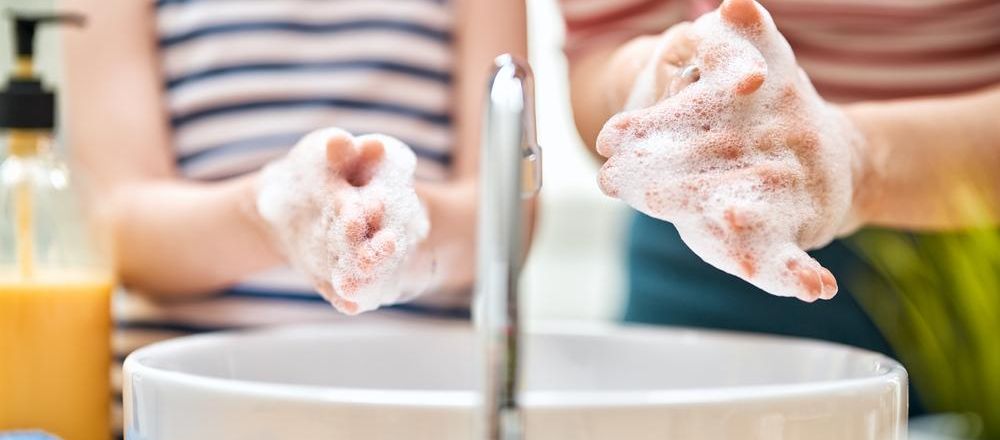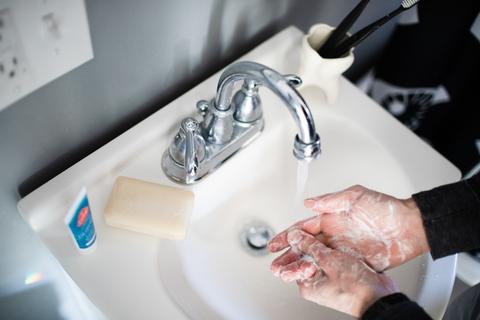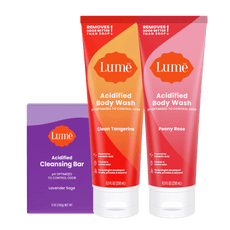
Handwashing: Its Surprising History and How Soap Really Works
by Sarah Thomas
You may have heard a thing or two about handwashing in recent news–it’s kind of a big deal right now.
Handwashing has long been a part of religious practice and personal hygiene. You probably learned about handwashing around the same time you were learning colors, how to count, and the importance of sharing. It’s pretty basic.
The significance of handwashing as it relates to health and preventing the spread of disease cannot be understated. However, handwashing is a relatively recent concept in the greater picture of human history. You may be surprised to hear it was disregarded and even regarded as a highly unpopular opinion not so many years ago.
Let’s get into a bit of the history behind the ritual that has a level of acceptance we take for granted, the science behind how handwashing really works to fend off germs and viruses, and what you really need to do it well.
Meet Doctor Semmelweis, “The Father of Hand Hygiene”
Dr. Ignaz Semmelweis was an obstetrician practicing in Vienna in the mid-1800s. Handwashing was not a regular practice at the time, and he had the audacity to suggest that handwashing (or, the lack thereof) might have something to do with the mortality of women infected during childbirth.
He observed that the mortality rate was three times higher in the doctors’ wards than in the midwives’ wards. He felt sure there was some kind of connection between the fact that doctors and medical students would perform examinations on women directly after working on cadavers. He insisted that the doctors in his clinic wash their hands after working on cadavers and observed a drastic drop in the mortality rate.
Happy with his success in saving lives, Dr. Semmelweis shared his discoveries and ideas about hygiene. The idea of handwashing was so preposterous to the scientific and medical community at the time that he was completely shunned, ignored, and ridiculed by his contemporaries.
Meanwhile, his contemporaries were busy “curing” patients through the practice of bloodletting. For centuries, people believed if someone was ill, an excess of blood was to blame. Doctors used leeches or made cuts in a patient’s skin and drained blood in order to cure disease. They had no knowledge of bacteria as the source of infection.
Imagine the frustration of knowing there was a connection between cleanliness and disease, but not having the ability to prove it. Dr. Semmelweis was unsuccessful at convincing other doctors and became so outspoken and obsessed with the idea of promoting handwashing, it took a toll on his mental health. With his mental health in decline, he was even less likely to persuade his colleagues that clean hands could save lives.
Tragically, Dr. Semmelweis died in an asylum at the very young age of 47. Ironically, he died of septic shock from infection. While unappreciated in his time, the general consensus is that his findings were instrumental in changing hand hygiene practices in healthcare settings.
The terrible tragedy is only made worse when you know that Louis Pasteur’s “germ theory of disease” became accepted only shortly after Dr. Semmelweis died in 1865. Pasteur was able to prove that food spoiled because of contamination by bacteria, and that led to understanding the link between bacteria and disease.
Because of Pasteur’s findings, the tiny and invisible world of microorganisms came into view and provided the missing link between handwashing and good health that Dr. Semmelweis had been so certain of. If only we could go back in time and put these two in a room together to collaborate.
The 1980’s: Big Hair, Acid-Washed Jeans, and Handwashing Guidelines in Healthcare Made Official
Knowing what we know now, it’s quite a shocker to learn how recently handwashing became common practice in healthcare settings in the United States.
It’s also surprising to find out it wasn’t until the 1980’s that the first national guidelines for hand hygiene were published by the CDC (Center for Disease Control). Since then, a number of additional guidelines have been established, and today, there are all kinds of rules and regulations the CDC has put in place to protect patients and healthcare workers from communicable diseases that are easily spread in healthcare settings.
We are lucky that the discoveries of Dr. Semmelweis and Louis Pasteur came before us and that the world we live in now has caught on to handwashing importance.
What About Hygiene At Home?
Many parents want their children to believe there is a secret handwashing police force deployed in each home (which also manages toothbrushing–they report kids who claimed to brush but just got their toothbrush wet). However, it’s really up to you to establish good personal hygiene practices in your home.
The CDC does have a campaign designed to raise awareness for personal hygiene called Clean Hands Save Lives. According to the CDC, washing your hands with soap and water is the best practice at home. Read here for the CDC’s full recommendations on when and how to wash your hands, and what’s best practice for hand sanitizing.
What Exactly Is Soap?
Soap is made by combining fatty acids like palm oil with water and an alkali salt like sodium chloride. The chemical reaction of the emulsified union is called saponification.
Early soap was made with wood ash combined with animal fat. After wood burns, the ash that remains is made up of an alkali salt commonly called lye, a common ingredient still used in soap today. There is evidence of soap making in many ancient civilizations, but soap was mainly used then for cleaning clothes rather than for personal hygiene.
Modern soapmaking is a bit more sophisticated, but it relies on the very same chemical process that was used anciently.
Fun fact: In underdeveloped countries where soap may not be available, The Worldwide Health Organization (WHO) currently recommends washing hands with ash as an alternative to soap, because ash is a sodium salt - one of the basic ingredients of soap.
Soap Gets Rid of Germs In an Extraordinary Way!
The function of soap is to separate oil and dirt from the source and wash it away with water. Soaps have a unique molecular structure that helps water become more effective at washing away dirt and oils, especially when combined with friction. That’s why scrubbing your hands thoroughly is also the key to removing the germs that attach themselves to dirt and oils!
John Emsley, a chemist from Cambridge University, explains why soap works so well: "Soap molecules have a head and a tail. The head likes to attach itself to water; the tail likes to attach itself to grease. So when soap is put into water, it will find the grease, it will attach itself to the grease, and it will pull it into the water and then it can be washed away."
When A Humble Bar of Soap Becomes A Hero
Germs get washed down the drain along with the oil and dirt from your skin. But what makes soap particularly effective at battling viruses on your skin, has to do with their structure.
Viruses are surrounded by a thin layer of fat. Soap molecules have one end that wants to grab on to the fat, or grease, surrounding the virus, while the other end pulls in the opposite direction and wants to attach itself to water. The ending result is not so good for a virus, and it gets pulled apart. Kapow!

Don’t Rush Genius
Soap is clearly a genius superhero when it comes to fighting supervillain viruses, but you need to give it enough time to get the work done. That’s why it is recommended you wash your hands for at least 20 seconds, roughly the time it takes to sing “Happy Birthday” twice.
If you really want to add some excitement to your hand hygiene routine, thanks to a kid named William in the UK, you can generate a custom handwashing poster with the song of your choice at Wash Your Lyrics. I plugged in “Eye of The Tiger” by Survivor, and it makes for an invigorating clean. You could wallpaper your entire bathroom with posters of your favorite songs– the options are limitless.
Even if you think you have the smoothest hands, there are all kinds of tiny nooks and crannies on the surface of our skin that are just right for germ hideouts. Twenty seconds seems to be about the right amount of time to seek out, attach, and destroy.
Soap + Water + Friction + Time = Victory
Choose The Right Superhero
Batman is a little moody, Iron Man has some serious ego issues, Superman tries a little too hard to fit in...no superhero is completely perfect, and that includes soap!
Since soap pulls oils away from the skin, some soaps can dry out your skin. You want to choose a moisturizing soap that won’t strip your skin of the oils it worked so hard to produce.
Chemicals in soap meant to kill bacteria or increase lather can really throw off the delicate pH balance of your skin acid. This can leave your skin dry and unprotected from pathogens. In addition to the fact that it only takes good scrubbing along with plain soap and water to wash off germs, some chemicals in consumer antibacterial soaps can actually cause bacteria to develop resistance. For further reading on ingredients to avoid in soap, check out this blog.
As we say, Lume’s got you covered, and luxurious, high quality soap is only a click away.
Lume Triple Milled Soap does not contain chemical antibacterial agents and is free from sodium lauryl sulfate, parabens, phthalates, and dyes.
So roll a bar of Lume Soap in your hand, enjoy the rich lather, and wash away dirt and germs. You are fighting virus tyranny every time you wash, so take your sweet time!
Did you Lume today?

"Kapow" image by Andrew Martin from Pixabay
Recent Articles
- Your New Indulgence: Introducing Vanilla Bliss
April 04, 2025
- Feminine Hygiene Myths: A Tale As Old As Time
March 24, 2025
- Do Showers Control Body Odor?
March 18, 2025
- The Skin Loving Benefits of Mandelic Acid
February 28, 2025
- Why Is Acid In My Deodorant?
February 28, 2025
- What Are AHAs?
February 28, 2025
- 3 Helpful Tips For Getting Started
February 28, 2025
- Unlocking Smoother Looking Skin: Lume's Guide to Managing KP
January 29, 2025
- Drier Days Are In Your Pits’ Future!
January 15, 2025
- This Spray Slays
January 10, 2025
















